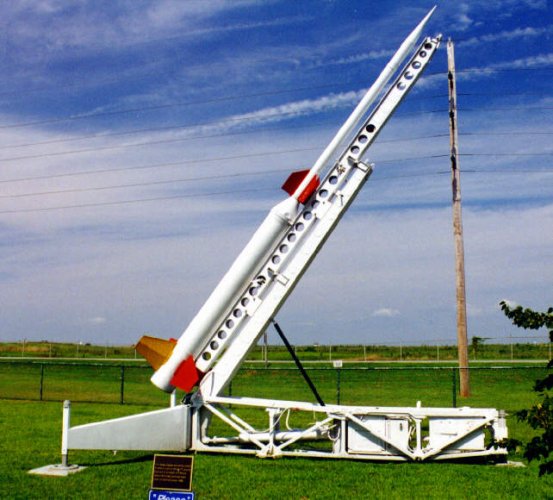University of Michigan/NACA RM-85/PWN-3 Nike-Cajun
In the early 1950s, the standard sounding rocket for high-altitude research was the Aerobee (for details, see XRM-84/PWN-2 Aerobee-Hi). However, this liquid-fueled rocket was relatively expensive and complicated to operate. Therefore various research agencies searched for simpler and cheaper rockets for routine high-altitude soundings and scientific experiments. One solution was to combine existing rocket boosters into multi-stage rockets, and the most important first stage motor for these applications was the M5 (X216A2) booster of the SAM-A-7/MIM-3 Nike Ajax anti-aircraft missile.
Following successful tests with Nike-Deacon combinations, the University of Michigan and the NACA developed a rocket with a more efficient upper stage under contract from the Air Force Cambridge Research Center (AFCRC). The result was the Thiokol TE-82 Cajun rocket, which was essentially a Deacon with an improved propellant. The first launch of a Nike-Cajun (also known as CAN for "Cajun And Nike") occurred in July 1956. The Nike booster was equipped with four instead of the normal three stabilizing fins. The Nike-Cajun could carry a payload between 4.5 kg (10 lb) and 45 kg (100lb), depending on the altitude requirement. A wide variety of payloads has been launched on Nike-Cajun rockets, including general upper atmosphere experiments, magnetic field experiments, horizon photography to obtain weather data, ionosphere experiments and astronomy payloads.
 |
| Photo: Sven Knudson, Ninfinger Productions |
| Nike-Cajun (PWN-3A) |
In April 1959, the USAF allocated the formal reconnaissance missile designation XRM-85 to the Nike-Cajun rocket at the request of the AFCRC, and in June 1963 this designation was changed to PWN-3A. Air Force use of the XRM-85/PWN-3A was limited, however, and probably ended in the mid-1960s. The Nike-Cajun was a very successful general purpose sounding rocket, and the last flight was launched by NASA in October 1976.
Specifications
Note: Data given by several sources show slight variations. Figures given below may therefore be inaccurate!
Data for PWN-3A:
| Length | 7.70 m (25 ft 3 in) |
| Diameter | 1st stage: 41.9 cm (16.5 in); 2nd stage: 16.5 cm (6.5 in) |
| Finspan | 1st stage: 1.51 m (59.5 in); 2nd stage: 0.63 m (25 in) |
| Weight | 700 kg (1550 lb) |
| Speed | 6760 km/h (4200 mph) |
| Ceiling | > 160 km (100 miles) |
| Propulsion | 1st stage: Allegheny Ballistics Lab. X216A2 solid-fueled rocket; 246 kN (55000 lb) for 3 s 2nd stage: Thiokol TE-82-1 Cajun solid-fueled rocket; 37 kN (8300 lb) for 2.8 s |
Main Sources
[1] Frederick I. Ordway III, Ronald C. Wakeford: "International Missile and Spacecraft Guide", McGraw-Hill, 1960
[2] Peter Alway: "Rockets of the World", Saturn Press, 1999
[3] Norman J. Bowman: "The Handbook of Rockets and Guided Missiles", Perastadion Press, 1963
[4] Department of Defense Missile Nomenclature Records
Back to Current Designations Of U.S. Unmanned Military Aerospace Vehicles
Back to Directory of U.S. Military Rockets and Missiles
Last Updated: 27 October 2002